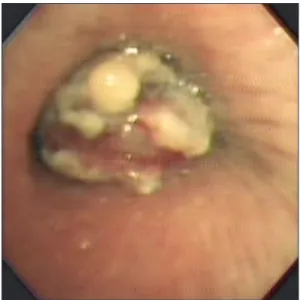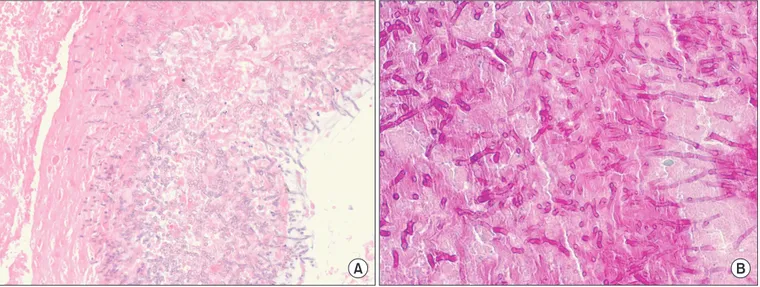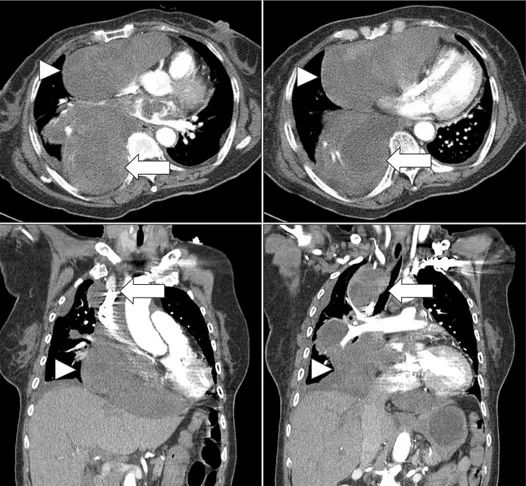A Case of Invasive Pulmonary Aspergillosis with Direct Invasion of the Mediastinum and the Left Atrium in an Immunocompetent Patient
Kyu-Hyun Han, M.D.
1, Jung-Hyun Kim, M.D.
1,2, Sun Young Shin, M.D.
1, Hye Yun Jeong, M.D.
1, Ji Min Chu, M.D.
1, Hak Su Kim, M.D.
1, Daejin Kim, M.D.
1, Minjung Shim, M.D.
1, Sang-Ho Cho, M.D.
3and Eun Kyung Kim, M.D.
1,21
Department of Internal Medicine,
2Division of Pulmonology,
3Department of Pathology, CHA Bundang Medical Center, CHA University, Seongnam, Korea
We report a case of invasive pulmonary aspergillosis invading the mediastinum and the left atrium. A 70-year-old woman was hospitalized for dyspnea. She had been well controlled for her diabetes mellitus and hypertension. The chest X-ray disclosed mediastinal widening, and the computed tomography scan of the chest showed that there was a large mediastinal mass and this lesion extended into the left atrium and right bronchus. The cardiac echocardiography showed that a huge mediastinal cystic mass compressed in the right atrium and a hyperechoic polypoid lesion in the left.
The pathology from the bronchoscopic biopsy observed abundant fungal hyphae which was stained with periodic acid- Schiff and Gomori's methenamine silver. Despite the treatment with antifungal agents, she died from cardiac tamponade after three months. Invasive pulmonary aspergillosis, which involves the mediastinum and the heart, is very rare in immunocompetent patients.
Keywords: Invasive Pulmonary Aspergillosis; Immunocompetence; Mediastinal Neoplasms; Heart Neoplasms
competent patients
1. In addition, invasive aspergillosis, which involves mediastinum in an immunocompetent host, was reported only once in the literature
2. To the best of our knowl- edge, this is the second case report of invasive pulmonary aspergillosis extending to the mediastium and the left atrium in an immunocompetent patient.
Case Report
A 70-year-old woman visited our hospital for mild dyspnea, cough, and sputum on March 6, 2012. She had been in a well- controlled state of her diabetes and hypertension since 2000.
The level of glycosylated hemoglobin A
1cwas 6.1% on admis- sion. She had no other medical history and did not administer medications such as corticosteroid or antibiotics. On admis- sion, body temperature was 37.4
oC, blood pressure 100/70 mm Hg, and pulse rate 92 beats per minute. Breath sounds Copyright © 2014
The Korean Academy of Tuberculosis and Respiratory Diseases.
All rights reserved.
Introduction
Although invasive pulmonary aspergillosis is not rare in immunocompromised patients, it is very rare in immuno-
Address for correspondence: Eun Kyung Kim, M.D.
Division of Pulmonology, Department of Internal Medicine, CHA Bundang Medical Center, CHA University School of Medicine, 59 Yatap- ro, Bundang-gu, Seongnam 463-712, Korea
Phone: 82-31-780-6141, Fax: 82-31-780-6143 E-mail: imekkim@cha.ac.kr
Received: Mar. 20, 2014 Accepted: Apr. 9, 2014
cc


